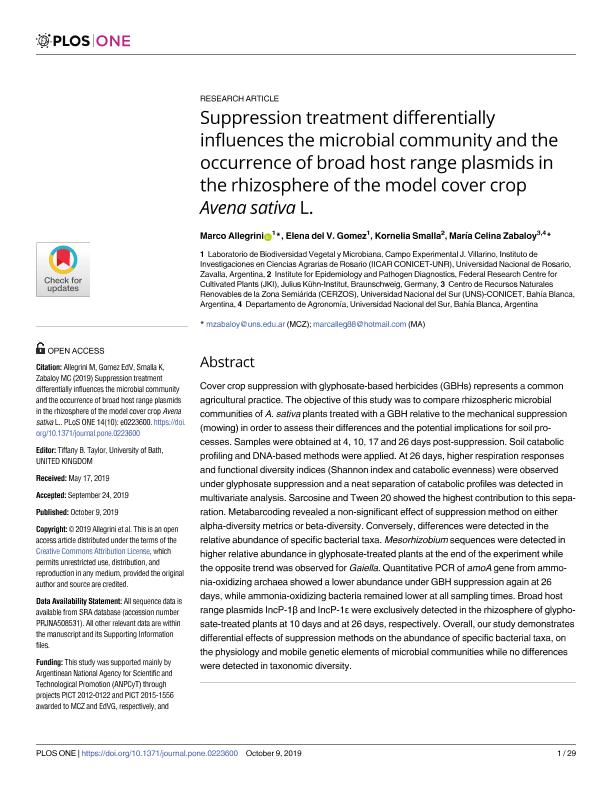Mostrar el registro sencillo del ítem
dc.contributor.author
Allegrini, Marco

dc.contributor.author
Gomez, Elena del Valle

dc.contributor.author
Smalla, Kornelia
dc.contributor.author
Zabaloy, Maria Celina

dc.date.available
2022-02-04T19:17:50Z
dc.date.issued
2019-10
dc.identifier.citation
Allegrini, Marco; Gomez, Elena del Valle; Smalla, Kornelia; Zabaloy, Maria Celina; Suppression treatment differentially influences the microbial community and the occurrence of broad host range plasmids in the rhizosphere of the model cover crop Avena sativa L.; Public Library of Science; Plos One; 14; 10; 10-2019; 1-29
dc.identifier.issn
1932-6203
dc.identifier.uri
http://hdl.handle.net/11336/151392
dc.description.abstract
Cover crop suppression with glyphosate-based herbicides (GBHs) represents a common agricultural practice. The objective of this study was to compare rhizospheric microbial communities of A. sativa plants treated with a GBH relative to the mechanical suppression (mowing) in order to assess their differences and the potential implications for soil processes. Samples were obtained at 4, 10, 17 and 26 days post-suppression. Soil catabolic profiling and DNA-based methods were applied. At 26 days, higher respiration responses and functional diversity indices (Shannon index and catabolic evenness) were observed under glyphosate suppression and a neat separation of catabolic profiles was detected in multivariate analysis. Sarcosine and Tween 20 showed the highest contribution to this separation. Metabarcoding revealed a non-significant effect of suppression method on either alpha-diversity metrics or beta-diversity. Conversely, differences were detected in the relative abundance of specific bacterial taxa. Mesorhizobium sequences were detected in higher relative abundance in glyphosate-treated plants at the end of the experiment while the opposite trend was observed for Gaiella. Quantitative PCR of amoA gene from ammonia-oxidizing archaea showed a lower abundance under GBH suppression again at 26 days, while ammonia-oxidizing bacteria remained lower at all sampling times. Broad host range plasmids IncP-1β and IncP-1ε were exclusively detected in the rhizosphere of glyphosate-treated plants at 10 days and at 26 days, respectively. Overall, our study demonstrates differential effects of suppression methods on the abundance of specific bacterial taxa, on the physiology and mobile genetic elements of microbial communities while no differences were detected in taxonomic diversity.
dc.format
application/pdf
dc.language.iso
eng
dc.publisher
Public Library of Science

dc.rights
info:eu-repo/semantics/openAccess
dc.rights.uri
https://creativecommons.org/licenses/by-nc-sa/2.5/ar/
dc.subject
AOB
dc.subject
INCP-1
dc.subject
GLYPHOSATE
dc.subject
METABARCODING
dc.subject.classification
Ciencias del Suelo

dc.subject.classification
Agricultura, Silvicultura y Pesca

dc.subject.classification
CIENCIAS AGRÍCOLAS

dc.title
Suppression treatment differentially influences the microbial community and the occurrence of broad host range plasmids in the rhizosphere of the model cover crop Avena sativa L.
dc.type
info:eu-repo/semantics/article
dc.type
info:ar-repo/semantics/artículo
dc.type
info:eu-repo/semantics/publishedVersion
dc.date.updated
2020-12-16T16:09:41Z
dc.journal.volume
14
dc.journal.number
10
dc.journal.pagination
1-29
dc.journal.pais
Estados Unidos

dc.journal.ciudad
San Francisco
dc.description.fil
Fil: Allegrini, Marco. Consejo Nacional de Investigaciones Científicas y Técnicas. Centro Científico Tecnológico Conicet - Rosario. Instituto de Investigaciones en Ciencias Agrarias de Rosario. Universidad Nacional de Rosario. Facultad de Ciencias Agrarias. Instituto de Investigaciones en Ciencias Agrarias de Rosario; Argentina
dc.description.fil
Fil: Gomez, Elena del Valle. Consejo Nacional de Investigaciones Científicas y Técnicas. Centro Científico Tecnológico Conicet - Rosario. Instituto de Investigaciones en Ciencias Agrarias de Rosario. Universidad Nacional de Rosario. Facultad de Ciencias Agrarias. Instituto de Investigaciones en Ciencias Agrarias de Rosario; Argentina
dc.description.fil
Fil: Smalla, Kornelia. Julius Kühn-institut; Alemania
dc.description.fil
Fil: Zabaloy, Maria Celina. Consejo Nacional de Investigaciones Científicas y Técnicas. Centro Científico Tecnológico Conicet - Bahía Blanca. Centro de Recursos Naturales Renovables de la Zona Semiárida. Universidad Nacional del Sur. Centro de Recursos Naturales Renovables de la Zona Semiárida; Argentina
dc.journal.title
Plos One

dc.relation.alternativeid
info:eu-repo/semantics/altIdentifier/doi/http://dx.doi.org/10.1371/journal.pone.0223600
dc.relation.alternativeid
info:eu-repo/semantics/altIdentifier/url/https://journals.plos.org/plosone/article?id=10.1371/journal.pone.0223600
Archivos asociados
